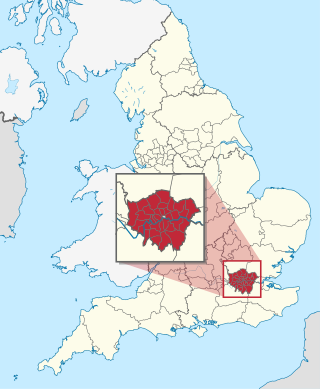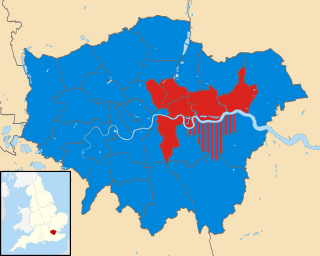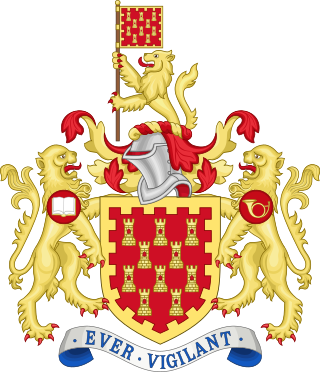
The Greater London Authority (GLA), colloquially known by the metonym "City Hall", is the devolved regional governance body of Greater London, England. It consists of two political branches: the executive Mayoralty and the 25-member London Assembly, which serves as a means of checks and balances on the former. Since May 2016, both branches have been under the control of the London Labour Party. The authority was established in 2000, following a local referendum, and derives most of its powers from the Greater London Authority Act 1999 and the Greater London Authority Act 2007.

The London boroughs are the 32 local authority districts that together with the City of London make up the administrative area of Greater London, England; each is governed by a London borough council. The present London boroughs were all created at the same time as Greater London on 1 April 1965 by the London Government Act 1963 and are a type of local government district. Twelve were designated as Inner London boroughs and twenty as Outer London boroughs. The City of London, the historic centre, is a separate ceremonial county and sui generis local government district that functions quite differently from a London borough. However, the two counties together comprise the administrative area of Greater London as well as the London Region, all of which is also governed by the Greater London Authority, under the Mayor of London.

The Greater London Council (GLC) was the top-tier local government administrative body for Greater London from 1965 to 1986. It replaced the earlier London County Council (LCC) which had covered a much smaller area. The GLC was dissolved in 1986 by the Local Government Act 1985 and its powers were devolved to the London boroughs and other entities. A new administrative body, known as the Greater London Authority (GLA), was established in 2000.

Metropolitan counties are a subdivision of England which were originally used for local government. There are six metropolitan counties: Greater Manchester, Merseyside, South Yorkshire, Tyne and Wear, West Midlands and West Yorkshire.

The Inner London Education Authority (ILEA) was the local education authority for the City of London and the 12 Inner London boroughs from 1965 until its abolition in 1990. From 1965 to 1986 it was an ad hoc committee of the Greater London Council; on 1 April 1986 it was reconstituted as a directly elected body corporate.

The School Board for London, commonly known as the London School Board (LSB), was an institution of local government and the first directly elected body covering the whole of London.
Sir Ernest Ashley Bramall was a British Labour Party politician, Member of Parliament for Bexley from 1946 to 1950 and Leader of the Inner London Education Authority (ILEA) for 11 years. He married twice - his first wife, Margaret, led the National Council for One Parent Families and looked after their two children.
(Peter) Neil Fletcher was a Labour politician and the last Leader of the Inner London Education Authority before its abolition.

Brinley Howard Davies, Baron Davies of Brixton, known as Bryn Davies, is a British trade unionist, actuary and politician who was Leader of the Inner London Education Authority in the early 1980s.
Frances Morrell was a British Labour politician who led the Inner London Education Authority from 1983 until 1987.
Lena Moncrieff Townsend was a British Conservative politician in London and served briefly as Leader of the Inner London Education Authority.

The second election to the Greater London Council was held on 13 April 1967, and saw the first Conservative victory for a London-wide authority since 1931.

The sixth election to the Greater London Council (GLC) was held on 7 May 1981. Following the election Andrew McIntosh the leader of the Labour Group was replaced by Ken Livingstone, a member of the party's left-wing. This was the last election to the GLC. The Conservative government of Margaret Thatcher soon took the decision to abolish the council in the mid-1980s. Following the abolition of the GLC, there was a direct election to the Inner London Education Authority in 1986.

The Local Government Act 1985 is an Act of Parliament in the United Kingdom. Its main effect was to abolish the six county councils of the metropolitan counties that had been set up in 1974, 11 years earlier, by the Local Government Act 1972, along with the Greater London Council that had been established in 1965. In their place many single purpose authorities known collectively as 'joint authorities' were established for fire service, police and passenger transport. An ad hoc education authority was established for Inner London and a planning authority for Greater London. The legislation permitted councils to form 'joint arrangements' for waste disposal and other services that they wished to provide together. Time-limited residuary bodies were created to dispose of the assets of the former authorities.

The Greater Manchester County Council (GMCC) was the top-tier local government administrative body for Greater Manchester from 1974 to 1986. A strategic authority, with responsibilities for roads, public transport, planning, emergency services and waste disposal, it was composed of 106 directly elected members drawn from the ten metropolitan boroughs of Greater Manchester. The Greater Manchester County Council shared power with ten lower-tier district councils, each of which directed local matters. It was also known as the Greater Manchester Council (GMC) and the Greater Manchester Metropolitan County Council (GMMCC).

Westminster City Council is the local authority for the City of Westminster in Greater London, England. The city is divided into 20 wards, each electing three councillors. The council is currently composed of 31 Labour Party members and 23 Conservative Party members. The council was created by the London Government Act 1963 and replaced three local authorities: Paddington Metropolitan Borough Council, St Marylebone Metropolitan Borough Council and Westminster Borough Council.
Cllr Nicholas Jerome Bennett JP is a British politician and a former Mayor of the London Borough of Bromley. A member of the Conservative Party, he served as a member of parliament (MP) from 1987 to 1992 representing the constituency of Pembrokeshire, and was a Parliamentary Under-Secretary of State at the Welsh Office from 1990 to 1992. In that role he had responsibility for the Welsh Health Service, Social Services, Housing and Local Government, Water and Sport.

West Yorkshire County Council (WYCC) – also known as West Yorkshire Metropolitan County Council (WYMCC) – was the top-tier local government administrative body for West Yorkshire from 1974 to 1986. A strategic authority, with responsibilities for roads, public transport, planning, emergency services and waste disposal, it was composed of 88 directly elected members drawn from the five metropolitan boroughs of West Yorkshire. West Yorkshire County Council shared power with five lower-tier district councils, each of which directed local matters.

Mair Eluned Garside was a Labour politician in London for more than 60 years.
Anne Hallowell Sofer is a former British politician.














